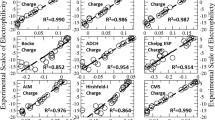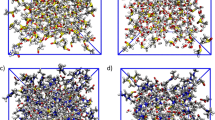Abstract
Context
In spite of the fact that molecular acidity is a fundamental physicochemical property of molecular systems, the vast majority of theoretical studies have focused attention on monoprotic acids and on the prediction of pKa’s. Polyprotic acids, represent a challenge for electronic structure calculations since the multiple acidic sites result in a vast group of species with different conformations and reactivities. In this work, Information-theoretic (IT) concepts of localizability, order and uniformity are applied to the Citric Acid and its deprotonated species through the one-electron density functionals: Shannon entropy (S), Fisher information (I) and Disequilibrium (D), respectively. We pursue the goal of characterizing the acidity of the aforementioned species with the aim to associate the IT concepts to chemical features such as the polarizability of the protonated/deprotonated species, the liability of the acidic sites, atomic electrostatic potentials, covalent bonding. IT analyses looks very promising for future studies on the acidity of specific deprotonation-sites of polyprotic acids.
Methods
Density functional theory (DFT) calculations were performed with Gaussian 09 program. A sensitivity analysis of the IT-measures was performed for the citric acid and the citrate using B3LYP, B3PW91, BPW91, M05-2X, M06-2X and PBEPBE functionals with the 6-311++g(3df,2p), 6-311++g(d,p), 6.311+g(d,p) and aug-cc-pVDZ basis sets. The rest of the analysis was performed with the M05-2X/6-311+G(d,p) level of theory. Additionally, aqueous media was considered by use of the SMD solvent model. The IT-measures were calculated using a suite of programs developed in our laboratory jointly with the DGRID software package.











Similar content being viewed by others
References
Galano A, Pérez-González A, Castañeda-Arriaga R, Muñoz-Rugeles L, Mendoza-Sarmiento G, Romero-Silva A, Ibarra-Escutia A, Rebollar-Zepeda AM, Leõn-Carmona JR, Hernández-Olivares MA, Alvarez-Idaboy JR (2016) Empirically fitted parameters for calculating pka values with small deviations from experiments using a simple computational strategy. J Chem Inf Model 56(9):1714–1724. https://doi.org/10.1021/acs.jcim.6b00310. (PMID: 27585285)
Cerar J, Podlipnik Č (2008) Relationships between aqueous acidities of benzene polycarboxylic acids and computed surface-electrostatic potential and charges. Acta Chim Slov 4(55):999–1008
Cao X, Rong C, Zhong A, Lu T, Liu S (2017) Molecular acidity: An accurate description with information-theoretic approach in density functional reactivity theory. J Comput Chem 39(2):117–129. https://doi.org/10.1002/jcc.25090
Szakács Z, Noszál B (1999) Protonation microequilibrium treatment of polybasic compounds with any possible symmetry. J Math Chem 26:139–155
Schulman SG, Rosenberg LS, Sturgeon RJ (1978) Spectroscopic approach to estimation of microequilibrium constants of prototropic reactions of aminobenzoic acids. J Pharm Sci (Philadelphia, PA, U. S.) 67(3):334–337 https://doi.org/10.1002/jps.2600670315
Noszál B, Visky D, Kraszni M (2006) Characterization of ester hydrolysis in terms of microscopic rate constants. J Phys Chem B 110(29):14507–14514. https://doi.org/10.1021/jp0620116. (PMID: 16854163)
Mazák K, Noszál B (2016) Advances in microspeciation of drugs and biomolecules: Species-specific concentrations, acid-base properties and related parameters. J Pharm Biomed Anal 130:390–403. https://doi.org/10.1016/j.jpba.2016.03.053. (Review Issue 2016)
Geerlings P, De Proft F, Langenaeker W (2003) Conceptual density functional theory. Chem Rev (Washington, DC, U. S.) 103:1793–1873
Lohr LL (1984) Protonic counterpart of electronegativity as an organizing principle for acidity and basicity. J Phys Chem 88(16):3607–3611. https://doi.org/10.1021/j150660a046
Lohr LL (1986) The protonic counterpart of electronegativity and its relationship to electronic and protonic hardness. In: Smith VH, Schaefer HF, Morokuma K (eds) Applied Quantum Chemistry. Springer, Dordrecht, pp 223–230
Ayers PW, Parr RG (2001) Variational principles for describing chemical reactions reactivity indices based on the external potential. J Am Chem Soc 123(9):2007–2017. https://doi.org/10.1021/ja002966g. (PMID: 11456823)
Makov G (1995) Chemical hardness in density functional theory. J Phys Chem 99(23):9337–9339. https://doi.org/10.1021/j100023a006
Pearson RG (2005) Chemical hardness and density functional theory. J Chem Sci 117:369–377. https://doi.org/10.1007/BF02708340
Parr RG, Donnelly RA, Levy M, Palke WE (1978) Electronegativity: The density functional viewpoint. J Chem Phys 68(8):3801–3807. https://doi.org/10.1063/1.436185
Nagy A (2013) Shannon entropy density as a descriptor of coulomb systems. Chem Phys Lett 556:355–358. https://doi.org/10.1016/j.cplett.2012.11.065
Nalewajski RF, Świtka E (2002) Information theoretic approach to molecular and reactive systems. Phys Chem Chem Phys 4:4952–4958. https://doi.org/10.1039/B200616M
Nalewajski RF (2003) Information principles in the theory of electronic structure. Chem Phys Lett 372(1):28–34. https://doi.org/10.1016/S0009-2614(03)00335-X
Zhou X-Y, Rong C, Lu T, Zhou P, Liu S (2016) Information functional theory: Electronic properties as functionals of information for atoms and molecules. J Phys Chem A 120(20):3634–3642. https://doi.org/10.1021/acs.jpca.6b01197. (PMID: 27115776)
Liu S, Rong C, Lu T (2014) Information conservation principle determines electrophilicity, nucleophilicity, and regioselectivity. J Phys Chem A 118(20):3698–3704. https://doi.org/10.1021/jp5032702. (PMID: 24784465)
Rong C, Lu T, Ayers PW, Chattaraj PK, Liu S (2015) Scaling properties of information-theoretic quantities in density functional reactivity theory. Phys Chem Chem Phys 17:4977–4988. https://doi.org/10.1039/C4CP05609D
Liu S-B (2016) Information-theoretic approach in density functional reactivity theory. Acta Phys-Chim Sin 32(1):98. https://doi.org/10.3866/PKU.WHXB201510302
Shannon CE (1948) A mathematical theory of communicationr. Bell Syst Tech J 27:379–423
Fisher RA (1925) Theory of statistical estimation. Math Proc Cambridge Philos Soc 22:700–725 Reprinted in Collected Papers of R. A. Fisher, edited by J.H. Bennet (University of Adelaide Press, South Australia, 1972) pp 15–40
Onicescu O (1966) Theorie de l’information. Energie informationelle. C R Acad Sci Paris A 263:25
Carbó R, Lleyda L, Arnau M (1980) How similar is a molecule to another? An Electron Density Measure of Similarity Between Two Molecular Structures 17:1185–1189. https://doi.org/10.1002/qua.560170612
Angulo JC, Antolín J, Esquivel RO (2011) In: Sen KD (ed) Atomic and molecular complexities: Their physical and chemical interpretations. Springer, Dordrecht, pp 167–213 https://doi.org/10.1007/978-90-481-3890-6_6
Esquivel RO, Molina-Espíritu M, López-Rosa S, Soriano-Correa C, Barrientos-Salcedo C, Kohout M, Dehesa JS (2015) Predominant information quality scheme for the essential amino acids: An information-theoretical analysis. ChemPhysChem 16(12):2571–2581
Esquivel RO, Liu S, Angulo JC, Dehesa JS, Antolín J, Molina-Espíritu M (2011) Fisher information and steric effect: Study of the internal rotation barrier of ethane. J Phys Chem A 115(17):4406–4415. https://doi.org/10.1021/jp1095272. (PMID: 21473613)
Molina-Espíritu M, Esquivel RO, Angulo JC, Antolín J, Iuga C, Dehesa JS (2013) Information-theoretical analysis for the \(S_N2\) exchange reaction \(CH_3Cl\) + \(F^-\). Int J Quantum Chem 113(24):2589–2599. https://doi.org/10.1002/qua.24510
Nalewajski RF (2008) Use of fisher information in quantum chemistry. Int J Quantum Chem 108(12):2230–2252 https://doi.org/10.1002/qua.21752
Hummer G, Garde S, García AE, Pohorille A, Pratt LR (1996) An information theory model of hydrophobic interactions. Proc Natl Acad Sci U S A 93(17):8951–8955 https://arxiv.org/abs/https://www.pnas.org/content/93/17/8951.full.pdfhttps://doi.org/10.1073/pnas.93.17.8951
Geerlings P, Borgoo A (2011) Information carriers and (reading them through) information theory in quantum chemistry. Phys Chem Chem Phys 13:911–922. https://doi.org/10.1039/C0CP01046D
Nagy A (2003) Fisher information in density functional theory. J Chem Phys 119(18):9401–9405. https://doi.org/10.1063/1.1615765
Parr RG (1980) Density functional theory of atoms and molecules. In: Fukui K, Pullman B (eds) Horizons of quantum chemistry. Springer, Dordrecht, pp 5–15
Cramer CJ (2004) Essentials of Computational Chemistry: Theories and Models. 2a edn: John Wiley & Sons Ltd
Marenich AV, Cramer CJ, Truhlar DG (2009) Universal solvation model based on solute electron density and on a continuum model of the solvent defined by the bulk dielectric constant and atomic surface tensions. J Phys Chem B 113(18):6378–6396. https://doi.org/10.1021/jp810292n. (PMID: 19366259)
Frieden BR (2004) Science from Fisher Information. Cambridge University Press, Cambridge
Dehesa JS, López-Rosa S, Manzano D (2010) Entropy and complexity analyses of \(d\)-dimensional quantum systems. In: Sen KD (ed) Statistical complexities: Applications in electronic structures. Springer, Dordrecht
Dennington R, Keith TA, Millam JM (2019) GaussView Version 6.0.16. Semichem Inc. Shawnee Mission KS
Ditchfield R, Hehre WJ, Pople JA (1971) Selfconsistent molecularorbital methods. ix. an extended gaussiantype basis for molecularorbital studies of organic molecules. J Chem Phys 54(2):724–728 https://doi.org/10.1063/1.1674902
Zhao Y, Schultz NE, Truhlar DG (2006) Design of density functionals by combining the method of constraint satisfaction with parametrization for thermochemistry, thermochemical kinetics, and noncovalent interactions. J Chem Theory Comput 2(2):364–382. https://doi.org/10.1021/ct0502763. (PMID: 26626525)
Frisch MJ, Trucks GW, Schlegel HB, Scuseria GE, Robb MA, Cheeseman JR, Scalmani G, Barone V, Mennucci B, Petersson GA, Nakatsuji H, Caricato M, Li X, Hratchian HP, Izmaylov AF, Bloino J, Zheng G, Sonnenberg JL, Hada M, Ehara M, Toyota K, Fukuda R, Hasegawa J, Ishida M, Nakajima T, Honda Y, Kitao O, Nakai H, Vreven T, Montgomery JA Jr, Peralta JE, Ogliaro F, Bearpark M, Heyd JJ, Brothers E, Kudin KN, Staroverov VN, Kobayashi R, Normand J, Raghavachari K, Rendell A, Burant JC, Iyengar SS, Tomasi J, Cossi M, Rega N, Millam JM, Klene M, Knox JE, Cross JB, Bakken V, Adamo C, Jaramillo J, Gomperts R, Stratmann RE, Yazyev O, Austin AJ, Cammi R, Pomelli C, Ochterski JW, Martin RL, Morokuma K, Zakrzewski VG, Voth GA, Salvador P, Dannenberg JJ, Dapprich S, Daniels AD, Farkas, Foresman JB, Ortiz JV, Cioslowski J, Fox DJ (2016) Gaussian 09 Revision E.01. Gaussian Inc. Wallingford CT 2009
Skyner RE, McDonagh JL, Groom CR, van Mourik T, Mitchell JBO (2015) A review of methods for the calculation of solution free energies and the modelling of systems in solution. Phys Chem Chem Phys 17:6174–6191. https://doi.org/10.1039/C5CP00288E
Breneman CM, Wiberg KB (1990) Determining atom-centered monopoles from molecular electrostatic potentials. the need for high sampling density in formamide conformational analysis. J Comput Chem 11(3):361–373https://doi.org/10.1002/jcc.540110311
Pérez-Jordá JM, Becke AD, SanFabin E (1994) Automatic numerical integration techniques for polyatomic molecules. J Chem Phys 100(9):6520–6534
Kohout M (2007) Program DGRID, version 4.2
Borioni JL, Puiatti M, Vera DMA, Pierini AB (2017) In search of the best dft functional for dealing with organic anionic species. Phys Chem Chem Phys 19:9189–9198. https://doi.org/10.1039/C6CP06163J
Chen J, Chan B, Shao Y, Ho J (2020) How accurate are approximate quantum chemical methods at modelling solute-solvent interactions in solvated clusters? Phys Chem Chem Phys 22:3855–3866. https://doi.org/10.1039/C9CP06792B
Wang Y, Cheng X, Xea Yang (2006) Dft study of solvent effects for some organic molecules using a polarizable continuum model. J Solution Chem 35:869–878. https://doi.org/10.1007/s10953-006-9034-0
Peverati R, Truhlar DG (2014) Quest for a universal density functional: the accuracy of density functionals across a broad spectrum of databases in chemistry and physics. Philos Trans R Soc A 372(2011):20120476. https://doi.org/10.1098/rsta.2012.0476
Sousa SF, Fernandes PA, Ramos MJ (2007) General performance of density functionals. J Phys Chem A 111(42):10439–10452. https://doi.org/10.1021/jp0734474. (PMID: 17718548)
Esquivel RO, Flores-Gallegos N, Dehesa JS, Angulo JC, Antolín J, López-Rosa S, Sen KD (2010) Phenomenological description of a three-center insertion reaction: An information-theoretic study. J Phys Chem A 114(4):1906–1916. https://doi.org/10.1021/jp908898w. (PMID: 20050637)
Tóth G, Hosztafi S, Kovács Z, Noszál B (2012) The site-specific basicity of thyroid hormones and their precursors as regulators of their biological functions. J Pharm Biomed Anal 61:156–164. https://doi.org/10.1016/j.jpba.2011.11.020
Acknowledgements
Authors thank the Laboratorio de Supercómputo y Visualización at UAM for allocation of supercomputing time. H.V-H. thanks financial support from the Consejo Nacional de Ciencia y Tecnología (CONACYT-México) for a M.Sc. fellowship (CVU: 993929).
Funding
Vázquez-Hernández H. thanks financial support from the Consejo Nacional de Ciencia y Tecnología (CONACYT-México) for a M. Sc. fellowship (CVU:993929).
Author information
Authors and Affiliations
Contributions
Vázquez-Hernández H. carried out theoretical calculations and made all pictures and tables. All authors discussed the results, commented and wrote the manuscript.
Corresponding author
Ethics declarations
Ethical approval
Not applicable.
Conflict of interest
The authors have no competing interests to declare.
Additional information
Publisher's Note
Springer Nature remains neutral with regard to jurisdictional claims in published maps and institutional affiliations.
Hazel Vázquez-Hernández and Rodolfo O. Esquivel contributed equally to this work.
Supplementary Information
Below is the link to the electronic supplementary material.
Rights and permissions
Springer Nature or its licensor (e.g. a society or other partner) holds exclusive rights to this article under a publishing agreement with the author(s) or other rightsholder(s); author self-archiving of the accepted manuscript version of this article is solely governed by the terms of such publishing agreement and applicable law.
About this article
Cite this article
Vázquez-Hernández, H., Esquivel, R.O. Phenomenological description of the acidity of the citric acid and its deprotonated species: informational-theoretical study. J Mol Model 29, 253 (2023). https://doi.org/10.1007/s00894-023-05589-2
Received:
Accepted:
Published:
DOI: https://doi.org/10.1007/s00894-023-05589-2




